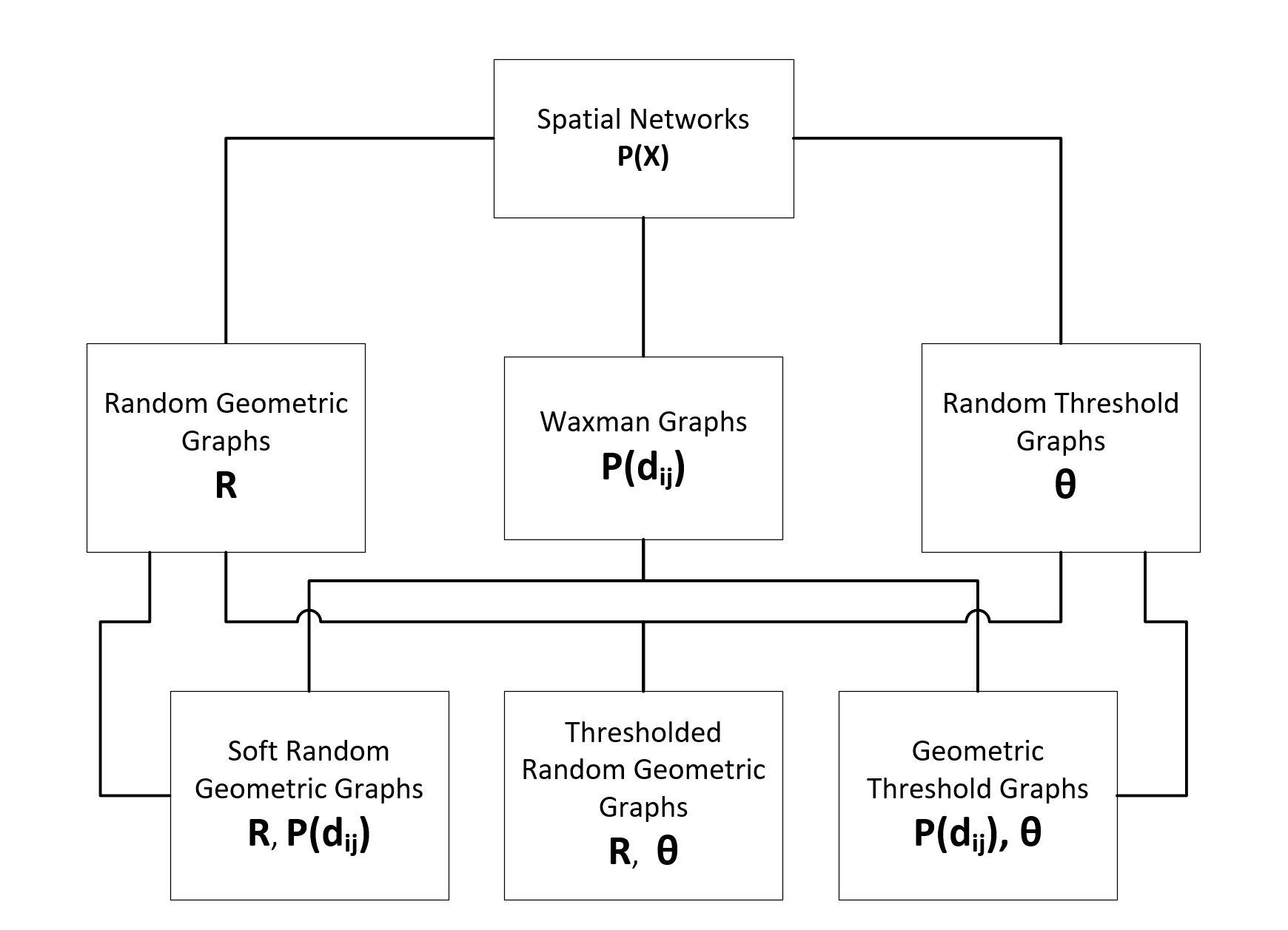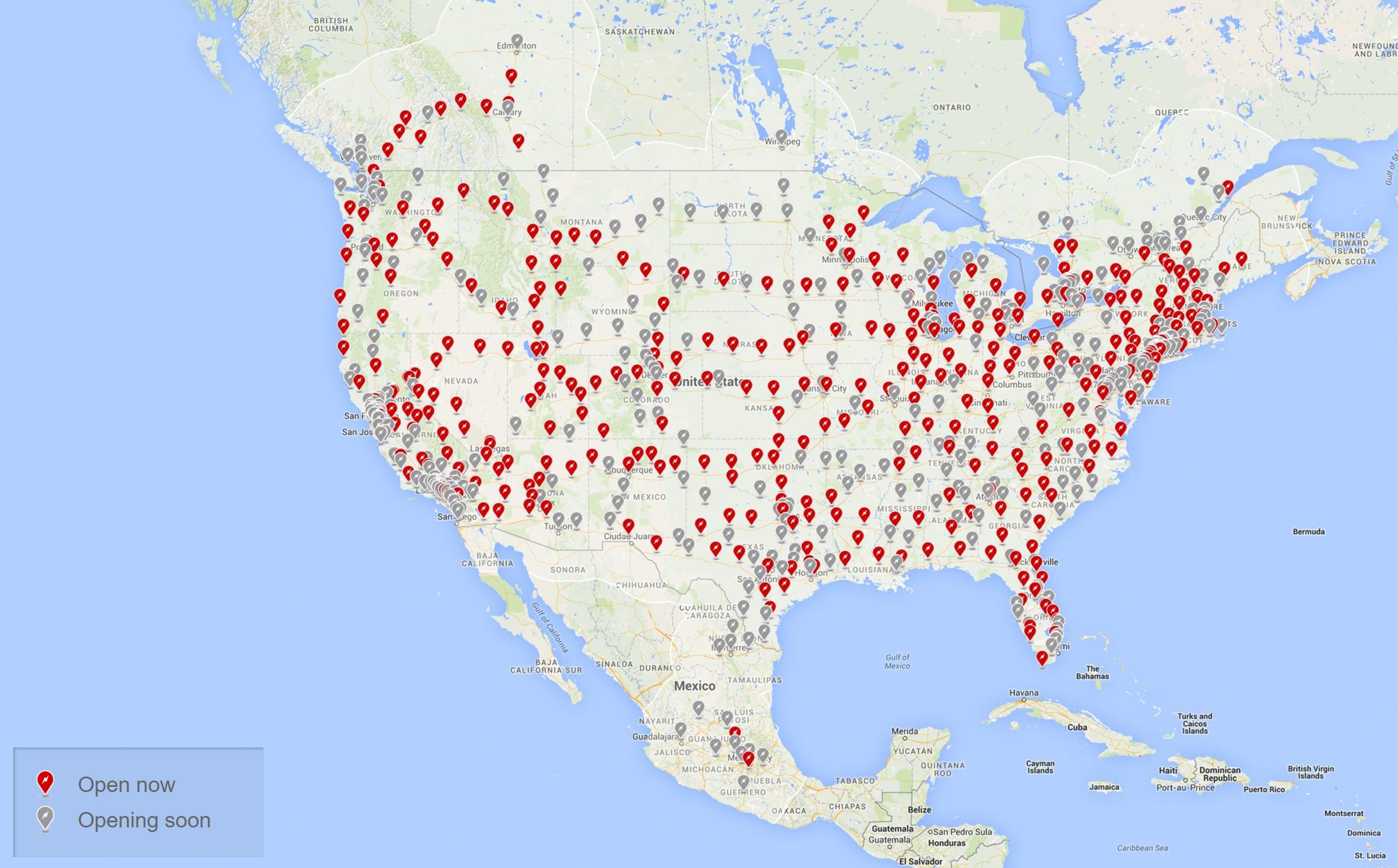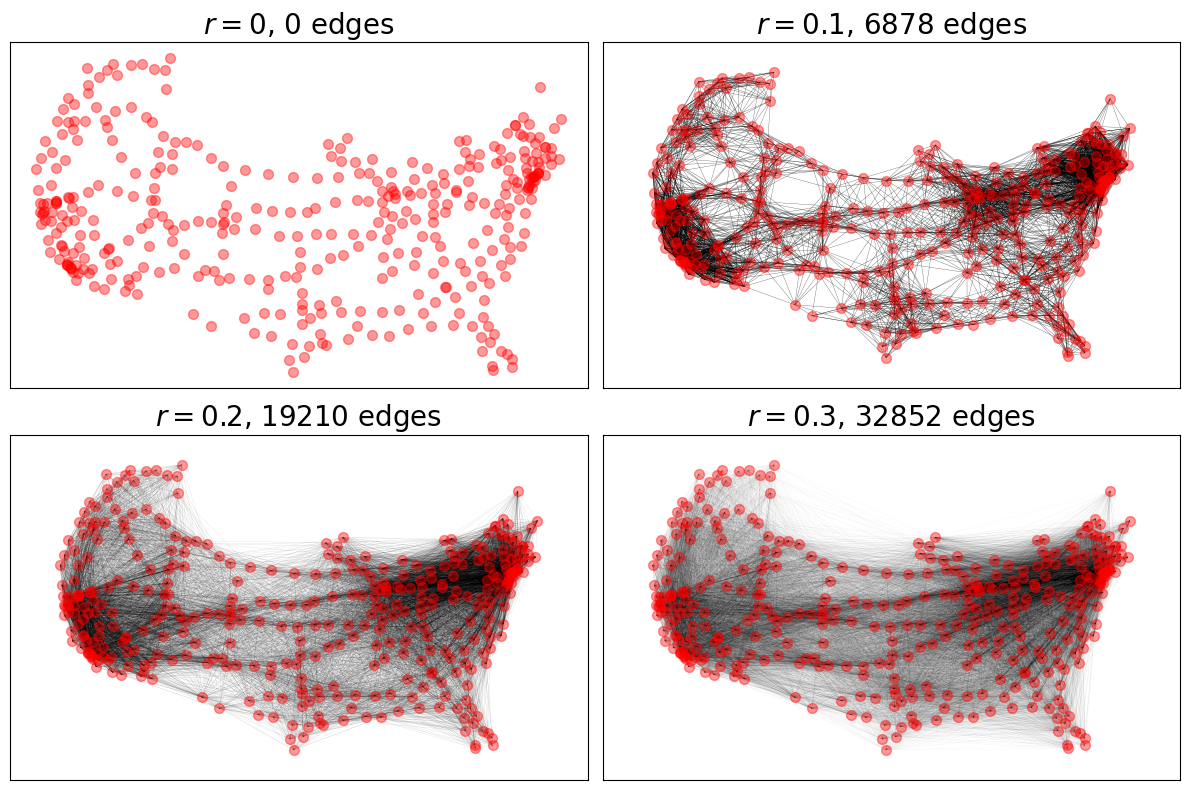Geometric Generator Models#
In this tutorial, we’ll explore the geometric network generator models implemented in networkx under networkx/generators/geometric.py and apply them to a real-world use case to learn how these models can be parameterized and used.
Geometric/Spatial Networks#
Many real-world complex systems have spatial components constraining the network structures these types of systems can produce. Infrastructure networks such as transportation, electrical, and telecommunication systems, social networks and even our own synaptic networks are all embedded in physical space. Spatial Networks provide a framework for network models having spacial elements where nodes are embedded in space and a metric is incorporated that dictates the conditions for connection between nodes. Typically, the probability of connection is a decreasing function of the metric, with most models assuming Euclidean distance in 2-dimensions or 3-dimensions. The intuition of most Spatial Network models propose that there exists an increasing cost of connection between nodes that are further apart, though arbitrary connection probability functions can be modeled.
The potential application of Spatial Networks to such a wide variety of real-world systems has motivated substainial research into these networks, with many unique but closely related models being proposed with theoretical proofs for many of their network properties. The 2010 Spatial Networks review article by Marc Barthélemy[1] provides a comprehensive overview of the field and reviews many of the most important theoretical proofs for the most common Spatial Network models. Here we explore some of the most typical Spatial Network models which have been implemented in the networkx package. These models can be classified using only three model parameters used by these different models:
radiusparameter in networkxp_distparameter in networkxthetaparameter in networkx
Typically, nodes are uniformly distributed onto the unit square and node weights
are sampled from some weight distribution.
Distance,
The figure below shows the relationships between Spatial Network Models connected by their shared parameterization.

Individual Model Definitions#
This section summarizes the various models. The notation
Random Geometric Graphs (
A d-dimensional Random Geometric Graph (RGG) is a graph where each of the
Waxman Graphs (
Waxman Graphs are the spatial generalization of Erdős–Rényi random graphs, where the
probability of connection of nodes depends on a function of the distance between them[4].
The original edge probabiliy function proposed by Waxman is exponential in
Where
The shape of the edge probabiliy function,
Threshold Graphs (
A simple graph G is a threshold graph if we can assign weights to the vertices
such that a pair of distinct vertices is adjacent exactly when the sum of their
assigned weights equals or exceeds a specified threshold,
Geographical Threshold Graphs (
Geographical Threshold Graphs are the geographical generalization of Threshold
Graphs, where a pair of vertices with weights
Soft Random Geometric Graphs (
A recent extention of Random Geometric Graphs couples the influence of distance
between nodes that are within the maximum connection distance,
Thresholded Random Geometric Graphs (
Thresholded Random Geometric Graphs extend RGGs to incorporate node weights into the model, where connections are only made between nodes with sufficiently powerful weights, up to a maximum connection distance between nodes [9].
A Motivating Example#
For this tutorial, we’ll use the Tesla North American Supercharger network to highlight how the various spatial network models implemented in networkx can be parameterized and used.

The Supercharger data is obtained from supercharger.info, filtered for the Canadian and American Supercharger locations, totaling 385 Opened Superchargers as of April 2017. The collected data has been structured into a Networkx Graph which is made up of nested dictionaries keyed on the geohash of each Supercharger’s GPS coordinates which have been converted into a projected embedding onto the unit square. Node weights are the population of cities for each Supercharger, as a percent of total North American population. With this dataset, we can model the supercharger network with the various spatial networks implemented in networkx.
%matplotlib inline
import numpy as np
import matplotlib.pyplot as plt
import networkx as nx
# Some matplotlib settings
mpl_params = {
"axes.titlesize": 20,
"figure.figsize": (12, 4),
}
plt.rcParams.update(mpl_params)
Next, we load the data and construct the graph.
# from networkx.readwrite import json_graph
import json
# load json-ed networkx datafile
with open("data/tesla_network.json") as infile:
G = nx.json_graph.node_link_graph(json.load(infile))
print(G)
Graph with 385 nodes and 0 edges
# example node data structure keyed on geohash of GPS cords
G.nodes["dr7k46ycwwb8"]
{'SC_index': 173,
'geohash': 'dr7k46ycwwb8',
'weight': 0.00014093906625032375,
'GPS_lon_lat': [-74.07126104459167, 41.49977498687804],
'lat': 41.49977498687804,
'lon': -74.07126104459167,
'population': 28101,
'pos': [0.8123107474668945, 0.42622282744786055],
'GPS': [41.49977498687804, -74.07126104459167]}
# extract pos and weight attributes for use in models
nodes = G.nodes()
pos = nx.get_node_attributes(G, "pos")
weight = nx.get_node_attributes(G, "weight")
Since we’ll be visualizing a lot of graphs, let’s define some general plotting options for consistent visualizations.
node_opts = {"node_size": 50, "node_color": "r", "alpha": 0.4}
edge_opts = {"edge_color": "k"}
Random Geometric Graphs#
For RGGs, we see the impact of increasing the maximum connection distance
parameter radius in increasing the number of connections.
fig, axes = plt.subplots(2, 2, figsize=(12, 8))
# Params for visualizing edges
alphas = (0.8, 0.8, 0.3, 0.1)
linewidths = (0.2, 0.2, 0.1, 0.1)
radii = (0, 0.1, 0.2, 0.3)
for r, ax, alpha, lw in zip(radii, axes.ravel(), alphas, linewidths):
RGG = nx.random_geometric_graph(nodes, radius=r, pos=pos)
nx.draw_networkx_nodes(G, pos=pos, ax=ax, **node_opts)
nx.draw_networkx_edges(RGG, pos=pos, ax=ax, alpha=alpha, width=lw, **edge_opts)
ax.set_title(f"$r = {r}$, {RGG.number_of_edges()} edges")
fig.tight_layout()

# Make edge visualization more prominent (and consistent) for the following
# examples
edge_opts["alpha"] = 0.8
edge_opts["width"] = 0.2
Geographical Threshold Graphs#
The GTG model allows for a wide range of custom parameters including custom node
positioning, weights, and a metric between nodes and the probability of connection,
fig, axes = plt.subplots(1, 2)
# Custom distance metric
dist = lambda x, y: sum(abs(a - b) for a, b in zip(x, y))
distance_metrics = {
"Default (Euclidean) distance metric": None, # Euclidean distance
"Custom distance metric": dist,
}
for (name, metric), ax in zip(distance_metrics.items(), axes.ravel()):
GTG = nx.geographical_threshold_graph(
nodes, 0.1, pos=pos, weight=weight, metric=metric
)
nx.draw_networkx_nodes(G, pos=pos, ax=ax, **node_opts)
nx.draw_networkx_edges(GTG, pos=pos, ax=ax, **edge_opts)
ax.set_title(f"{name}\n{GTG.number_of_edges()} edges")
fig.tight_layout()

fig, axes = plt.subplots(1, 2)
# Evaluate different p_dists
import math
from scipy.stats import norm
p_dists = {
"p_dist=Exponential": lambda d: math.exp(-d),
"p_dist=Normal": norm(loc=0.1, scale=0.1).pdf,
}
for (name, p_dist), ax in zip(p_dists.items(), axes.ravel()):
GTG = nx.geographical_threshold_graph(
nodes, 0.01, pos=pos, weight=weight, metric=dist, p_dist=p_dist
)
nx.draw_networkx_nodes(G, pos=pos, ax=ax, **node_opts)
nx.draw_networkx_edges(GTG, pos=pos, ax=ax, **edge_opts)
ax.set_title(f"{name}\n{GTG.number_of_edges()} edges")
fig.tight_layout()

Soft Random Geometric Graphs#
SRGGs utilize the maximum connection distance parameter, lambda=1.
fig, axes = plt.subplots(1, 3)
pdfs = {
"default": None, # default: exponential distribution with `lambda=1`
r"$e^{-10d}$": lambda d: math.exp(-10 * d),
"norm": norm(loc=0.1, scale=0.1).pdf,
}
for (title, pdf), ax in zip(pdfs.items(), axes.ravel()):
SRGG = nx.soft_random_geometric_graph(nodes, 0.1, pos=pos, p_dist=pdf)
nx.draw_networkx_nodes(G, pos=pos, ax=ax, **node_opts)
nx.draw_networkx_edges(SRGG, pos=pos, ax=ax, **edge_opts)
ax.set_title(f"p_dist={title}\n{SRGG.number_of_edges()} edges")
fig.tight_layout()

Thresholded Random Geometric Graphs#
TRGGs allow for the coupling of the maximum connection distance and threshold parameters.
The default weights for TRGG are drawn from an exponential distribution with
rate parameter lambda=1.
fig, axes = plt.subplots(1, 2)
# Increased threshold parameter, theta, reduces graph connectivity
thresholds = (0.0001, 0.001)
for thresh, ax in zip(thresholds, axes):
TRGG = nx.thresholded_random_geometric_graph(
nodes, 0.1, thresh, pos=pos, weight=weight
)
nx.draw_networkx_nodes(G, pos=pos, ax=ax, **node_opts)
nx.draw_networkx_edges(TRGG, pos=pos, ax=ax, **edge_opts)
ax.set_title(f"Threshold = {thresh}, {TRGG.number_of_edges()} edges")
fig.tight_layout()

